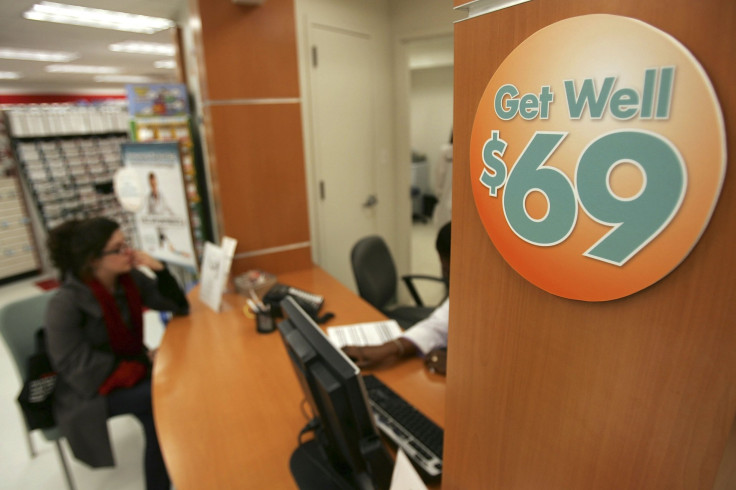Touted As The Cheaper Option, Retail Health Clinics Might Actually Raise Healthcare Costs, Study Suggests

All Rick Krieger wanted was a quick strep test.
His son had a sore throat, so Krieger drove him to an urgent care center in Minneapolis, where they waited for a test — for two hours. The experience frustrated Krieger enough that by the following year, in 2000, Krieger had co-founded QuickMedX, a clinic in local Minnesota grocery stores where people could get tests and medicine for their colds, earaches and other minor ailments. The idea caught on, with CVS buying QuickMedX in 2002 and renaming it MinuteClinic. Other companies, from Walgreens to Target, followed suit by opening clinics of their own.
Today the U.S. has nearly 2,000 retail clinics that receive more than 6 million visitors every year. Policymakers have touted the efficiency of retail clinics as chipping away at the $3 trillion the country spends every year on healthcare. But a new analysis, published Monday in the journal Health Affairs, casts doubt on that estimate, adding to a growing body of evidence — bolstered by warnings from physicians — that these clinics may actually drive up healthcare spending. The analysis raises broader questions about the unintended costs and consequences of experimentation and disruption in the healthcare industry.
“They don’t appear to be saving money,” said Scott Ashwood, the lead author of the study who is an associate policy researcher with RAND, a nonprofit research organization. The main reason? “There’s a lot of new use associated with retail clinics,” he explained. This finding that could have major implications for insurers and employers that cover large proportions of medical costs, especially as other options, such as telemedicine or clinics at work, gain popularity and prevalence.
Particularly popular among millennials, retail clinics, staffed typically with nurse practitioners and physician assistants and offering extended hours and walk-in policies, have been praised as a cheaper alternative to doctors’ offices and pricey emergency rooms. But Ashwood and his fellow researchers wondered if that was actually true, so they analyzed three years’ worth of claims data from the health insurer Aetna across 22 U.S. cities.
They compared spending between two sets of patients, those who did and those who did not use retail clinics, for 11 “low-acuity” ailments like earaches or coughs. They also analyzed the data to distinguish whether a visit to a retail clinic constituted a “substitution,” where the patient picked a retail clinic over a doctor’s office or emergency room, or a new visit altogether, where the patient would not have otherwise sought medical treatment.
The researchers found that on average, about three-fifths of retail clinic visits for these minor medical issues constituted new visits. Patients who used retail clinics for low-grade illnesses spent $14 more per year, even though the Convenient Care Association, a trade group for retail clinics, estimates these clinics are 30 to 40 percent cheaper than a visit with a physician and 80 percent less expensive than an emergency room. The amount itself may seem minimal, especially given that annual healthcare spending amounts to nearly $10,000 per person, but the fact that retail clinics drove spending — rather than curtailed it — at all was significant.
The reasons for the uptick in spending likely varied and could not be explained by the data Ashwood and his fellow researchers used, he said. One possibility was that retail clinics’ longer hours and shorter waiting times drew patients who were short on time, who might otherwise take an Advil for an earache and move on with the day. Many of the ailments the study looked at were considered “self-limiting,” meaning that with time and without treatment they were likely to subside.
But minor ailments can sometimes blossom into much bigger ones, and that’s precisely why advocates of retail clinics bill them as money savers: It’s far less expensive to treat a cough in its early stages, before it becomes bronchitis, or pneumonia.
Retail clinics “may reduce healthcare costs by providing preventative care ... and facilitating earlier access to care,” Tine Hansen-Turton, the executive director of the Convenient Care Association, said in an email. Without retail clinics, patients were more likely to go to emergency rooms that cost hundreds of dollars more per visit.
The Center for Medical Progress at the Manhattan Institute, which does policy research, suggested in a report published in February 2011 that retail clinics could help save “millions of dollars annually” — in the state of New York, they could cut $350 million in costs from 2011 to 2020 — by absorbing patients who would otherwise have gone to emergency rooms.
Doctors, meanwhile, are more skeptical about the purported value of these clinics. “While retail clinics may provide a limited scope of health care services for patients, this can ultimately lead to fragmentation of the patient’s health care,” a statement from the American Academy of Family Physicians warns. Getting medical care in this disjointed way, with a visit to a clinic here, another doctor there, could lead each of those clinicians to miss health warning signs that a physician who knows her patient well would be able to detect.
If anything, the results of his study raised many more questions, Ashwood said. And though the current trend in healthcare is to put medical care literally at a patient’s fingertips, from telemedicine to ask-a-doctor apps, the impact of those new options has not been determined.
“How are people using these new convenient options?” Ashwood asked. “What can we expect as they become more available?” For him, those are questions for another study.
© Copyright IBTimes 2024. All rights reserved.





















